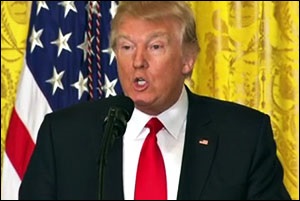By Pam Martens and Russ Martens: March 6, 2018
On January 20, 2017, the date of Donald Trump’s inauguration as President of the United States, the giant aerospace company, Boeing, closed the trading day at $159.53. Yesterday, it clocked in at $352.75 by the closing bell. The Trump era has added 122 percent to the pockets of Boeing shareholders, giving it a market cap of $207.6 billion.
Trump’s erratic reign had been good for Boeing – right up until Thursday, March 1, when Trump announced that he would be imposing 25 percent tariffs for foreign-made steel and 10 percent for aluminum. The stock market took a dive along with Boeing on the announcement.
Boeing is not just your average publicly-traded stock. It’s one of the 30 components in the Dow Jones Industrial Average, which is an index that affords greater weight to a stock based on its price. At yesterday’s closing price of $352.75, Boeing is by far the most expensive stock in the Dow. As such, it has a weighting of 9.76 percent of Dow performance. That compares with GE, the cheapest stock in the Dow, which registered a closing price of $14.42 yesterday and has a minuscule weighting of 0.40 percent in the Dow.
Trump has been a serial Tweeter about how his presidency has buoyed the Dow. Now, ironically, his steel and aluminum tariffs could be the undoing of that blissful relationship – in no small part because of Boeing’s precarious situation in the midst of a full blown trade war.
The problem isn’t that Boeing will see its aluminum costs for its planes rise dramatically. Morningstar analyst Chris Higgins notes the following in that regard:
“We expect no material impact on Boeing’s costs from tariffs. First, steel exposure is minimal: steel (25% tariff under Trump’s plan) accounts for about 15% of weight on older aircraft and around 10% on newer models. According to Alix Partners, a consulting firm, aluminum accounts for 79% of the weight of the 737. However, aerostructures represent roughly 30% of aircraft costs, meaning that if 100% of the 10% tariff hits Boeing, we estimate the airframer will experience only a 2.5% cost increase. We’d note that customer contracts contain escalation clauses, which means Boeing might be able to pass through the increase. Newer aircraft, the 787 for example, use about 20% aluminum as a percentage of weight, making the impact more negligible.”
Boeing’s potentially serious problems reside elsewhere. Boeing is America’s largest manufacturing exporter and derives 55 percent of its revenues from foreign countries. According to Boeing’s website, it has a backlog of half a trillion dollars in orders. Morningstar analyst Higgins estimates that while Boeing’s official figures show Chinese orders at just 304 aircraft, he believes that “over 70% of the 1,090 of unidentified orders on Boeing’s books will be delivered to Chinese customers (airlines and lessors),” giving China about 20 percent of Boeing’s total backlog. (Boeing concedes on its website that some of its customers have asked for anonymity on their orders.)
In dollars and cents, that would mean that about $100 billion of Boeing’s backlog rests on the relationship and goodwill it has with China. Just last November, Boeing signed a $37 billion deal in China for 300 airplanes.
Bloomberg’s David Fickling reported on March 2 why a tariff war with China could not come at a worse time for Boeing. Fickling writes:
“China Inc. has a sound, self-interested rationale for pursuing an aggressive path. Commercial Aircraft Corp. of China Ltd., or Comac, is hoping to pitch its C919 jet as a homegrown competitor to Boeing’s 737 and Airbus’ A320, and it announced last month that it would make its first delivery in 2021.
“Using a trade war to put one of the C919’s rivals on the back foot seems the perfect way to crack open the Boeing-Airbus duopoly and advance the interests of China’s own manufacturers. Should the current tit-for-tat over steel and aluminum spiral toward a trade war, few firms will find themselves in a more precarious position than Boeing.”
It’s not only the Dow Jones Industrial Average that could be at stake in a retaliatory trade war. Real jobs could be at stake as well. Boeing currently employs over 141,000 people with 50,000 factory jobs and more than 45,000 engineers. Its largest employment bases are in Washington state with more than 65,000 jobs; California with more than 12,000 jobs; and Missouri with more than 13,000 jobs.
Boeing manufactures the 737, 747, 767, 777 and 787 families of airplanes with new product developments including the Boeing 787-10 Dreamliner, the 737 MAX, and the 777X. The company reports that “more than 10,000 Boeing-built commercial jetliners are in service worldwide, which is almost half the world fleet.” The company is also a major manufacturer of freighters, reporting that “about 90 percent of the world’s cargo is carried onboard Boeing planes.”
Boeing’s domestic workforce is not the end of the story either. The company says that in 2016, it paid “nearly $45 billion to more than 13,600 businesses, supporting an additional 1.3 million supplier-related jobs in the United States.”
The giant aerospace company clearly does not want a trade war with China. But it’s up against some powerful people who have the President’s ear. Just days before Trump made his steel and aluminum tariff announcement, the Alliance for American Manufacturing began running a TV ad shaming the President for his unfulfilled campaign promises. (See video below.) The ad says:
“We heard the promises. Now it’s time for action. President Trump, America’s workers are counting on you to protect our jobs and to defend our national security. It’s time to keep the promise and to protect American Steel.”
The question is whether the President and his advisers have carefully thought through the ramifications to the U.S. economy of a retaliatory tariff war.


